Hops in Beer Brewing: Riwaka
Published: October 22, 2025 at 9:50:40 PM UTC
Riwaka hops, identified by the international code RWA, were introduced in 1996 by NZ Hops Ltd. They are a New Zealand aroma hop. This cultivar, also known as D-Saaz or SaazD (85.6-23), is a result of a triploid cross. It combines an old Saazer line with New Zealand breeding selections. This blend creates a unique Riwaka hop profile, captivating brewers and sensory analysts globally.
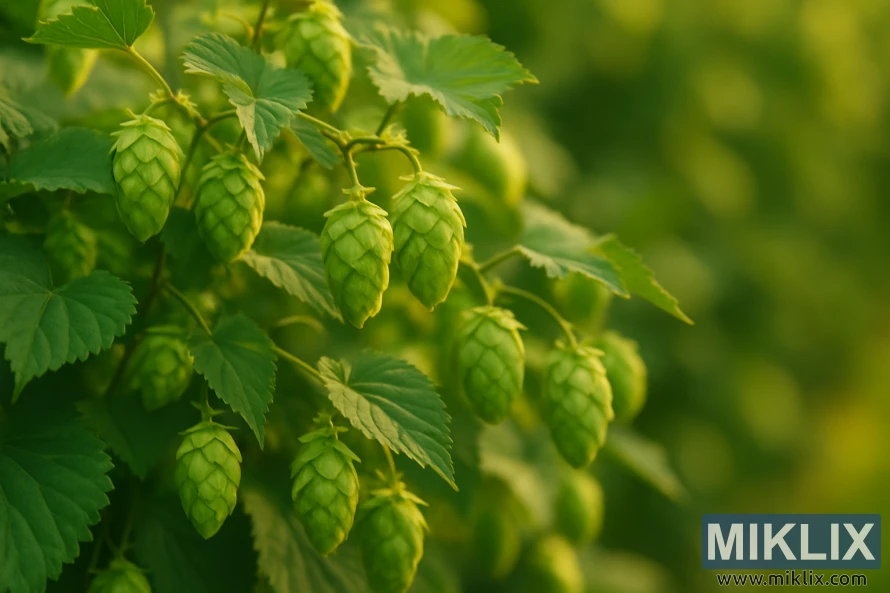
Key Takeaways
- Riwaka hops (RWA hop) originate from a Saazer lineage crossed with New Zealand selections and are managed by NZ Hops Ltd.
- The Riwaka hop profile emphasizes bright citrus and herbal notes suited to aroma-focused brewing.
- This guide is written for U.S. commercial and homebrewers, sensory analysts, and beer lovers seeking practical use and technical detail.
- Sections will cover origin, chemistry, brewing techniques, style matches, substitutions, and sensory evaluation.
- Expect actionable tips for incorporating Riwaka into single-hop beers and blends to highlight New Zealand hops character.
What Are Riwaka Hops and Their Origin
Riwaka is a New Zealand aroma hop, known internationally as RWA and cultivar ID SaazD (85.6-23). It was released in 1996. The origin of Riwaka hops is rooted in New Zealand's hop breeding programs. These programs aimed to blend the noble Saaz character with modern intensity.
The history of Riwaka starts with careful breeding. Breeders crossed a triploid variety with an old Saazer line. They chose New Zealand breeding parents for this mix. This is why Riwaka combines Saaz-like noble notes with tropical and citrus flavors typical of New World hops.
NZ Hops Ltd. owns and manages Riwaka. It is found in hop catalogs and supplier inventories globally. In New Zealand, growers harvest Riwaka from late February to early April. This period influences wet-hop use and crop-year variation for brewers.
For buyers, the origin of Riwaka is crucial. It is widely listed by hop suppliers and sold through various vendors, including online retailers and Amazon. Availability can change by harvest year, quantity, and price. Brewers often compare catalogs and harvest notes before making a purchase.
Flavor and Aroma Profile of Riwaka Hops
Riwaka is celebrated for its intense aroma and robust flavors. It's often added late in brewing to preserve its volatile oils. This method ensures the hop's fruit and citrus notes remain vibrant in the beer.
The hop's primary characteristics include a strong tropical fruit presence and a vivid passion fruit aroma. Tasters frequently note its grapefruit and clean citrus notes, which cut through malt sweetness. These qualities make Riwaka a favorite for beers that emphasize aroma.
Riwaka boasts a higher-than-average oil content, nearly double that of its Saaz parent. This high oil level is why its aromatics are so intense and immediate. Expect a concentrated fruit ester and sharp citrus lift when used late in the boil or during dry hop contact.
Some brewers report aggressive aromatics in certain applications. In rare cases, aging can reveal unexpected notes; one brewer described a diesel-like aroma after a month of lagering a Czech Pilsner with Riwaka dry hopping. Such reports suggest testing and cautious dosing, plus evaluation over time.
- Tropical fruit: strong, juicy, bright
- Passion fruit hops: dominant, aromatic
- Grapefruit hops: zesty, bitter-sweet peel
- Citrus: clean, high-pitched lift
In IPAs, pale ales, or fruited saisons, Riwaka truly excels. Late additions and dry hops capture those volatile oils, preserving the hop's tropical essence. Small-scale trials are essential to find the right dose and contact time for the perfect aroma balance.
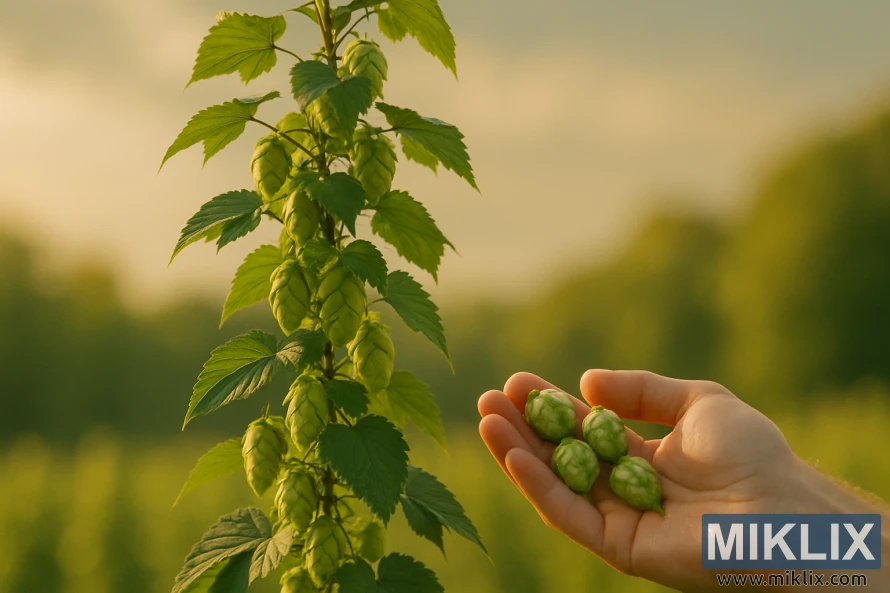
Brewing Values and Chemical Composition
Riwaka alpha acids range from 4.5% to 6.5%, averaging about 5.5%. This moderate level is ideal for adding aroma rather than bittering.
Beta acids are around 4% to 5%, averaging 4.5%. The alpha:beta ratio is usually 1:1, typical of aroma hops.
Co-humulone makes up 29% to 38% of alpha acids, averaging 33.5%. This moderate amount can influence bitterness if used in boil additions.
- Riwaka total oils: 0.8–1.5 mL/100g, averaging 1.2 mL/100g. High oil content contributes to its potent aroma.
- Riwaka myrcene: 67%–70%, averaging 68.5%. Myrcene is responsible for the hop's resinous, citrus, and fruity flavors.
- Riwaka humulene: 8%–10%, averaging 9%. Humulene adds woody, noble, and spicy notes.
Caryophyllene is present at 2%–6% (average 4%), adding peppery and herbal flavors. Farnesene is minimal, near 0%–1% (average 0.5%), contributing fresh, green notes.
Other terpenes, like β-pinene, linalool, geraniol, and selinene, comprise 13%–23% of the oil mix. These add floral and fruity nuances, enhancing dry hopping.
- For best aroma preservation, use Riwaka in late-boil additions or dry hopping.
- Long boils can volatilize oils, increasing alpha bitterness.
- Target whirlpool and dry-hop additions for maximum myrcene and humulene impact.
Crop-year variations affect all values. Lab analysis for a specific harvest is crucial for precise recipes. Knowing these ranges helps brewers achieve their desired bitterness and aroma.
How to Use Riwaka Hops in the Brewery
Riwaka excels as a late-boil and post-boil hop, preserving its tropical oils. Opt for minimal early additions in your hop schedules. Use small bittering hops for base IBUs, reserving Riwaka for flavor and aroma.
For whirlpool additions, add Riwaka at low temperatures to capture delicate esters. Adding Riwaka at 160–180°F (71–82°C) for 15–30 minutes enhances passion fruit and grapefruit notes. This approach avoids harsh vegetal character.
Dry hopping brings out Riwaka's bright top notes. Homebrewers typically use 0.5–2 oz per gallon, depending on desired intensity. Start conservatively for lagers, increasing rates for hazy pale ales and IPAs.
- Keep early-boil use minimal to avoid over-extracting bitterness from Riwaka.
- Use whole cones or standard pellets; no commercial lupulin concentrates are available from major processors for Riwaka.
- Consider wet-hop use during the late February–April New Zealand harvest for a fresher tropical profile.
When planning bitterness, remember Riwaka's alpha acids range from 4.5–6.5%. Adjust hop schedules and IBUs if adding at 60 minutes. This ensures the beer balances hop bite and aroma.
Run trial batches and taste over time. Beers with heavy Riwaka use may develop unusual notes during extended lagering. Sensory monitoring is key to catching changes early and making adjustments to future hop schedules.
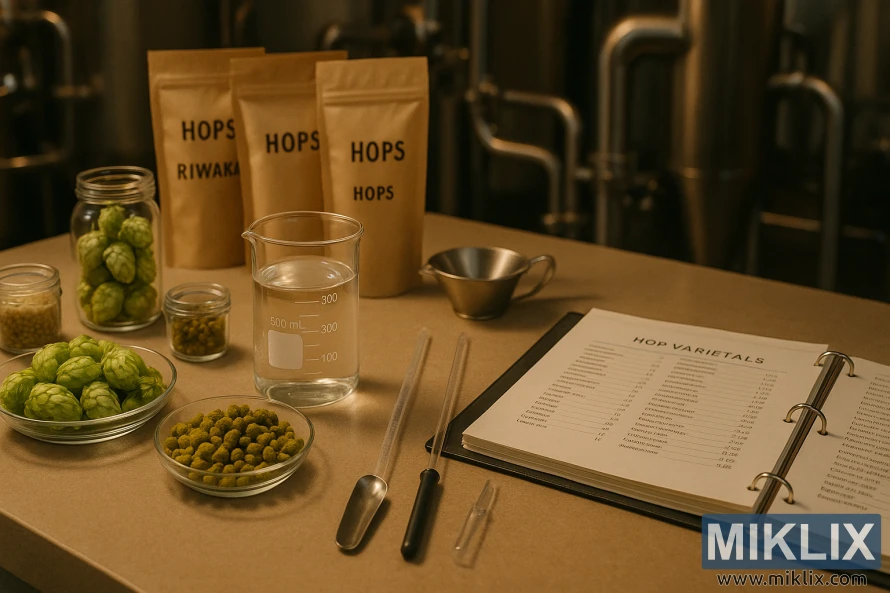
Beer Styles That Showcase Riwaka Hops
Riwaka hops introduce vibrant passion fruit, lime, and guava flavors, enhancing various beer styles. They are often added late or used for dry hopping. This method captures their aromatic oils without introducing harsh bitterness.
Riwaka pale ale is a perfect showcase. It features the hop's tropical and citrus notes prominently. The use of light caramel malts and controlled bitterness ensures the aroma takes center stage.
Riwaka IPA can be crafted in both hazy and West Coast styles. Hazy IPAs benefit from late and dry hop additions, emphasizing the fruitiness. West Coast versions, on the other hand, add a crisp citrus flavor balanced by firm bitterness.
Riwaka pilsner offers a unique twist when used sparingly. Late hop additions provide a subtle citrus enhancement in lagers. Brewers should monitor the aroma during lagering to ensure the best flavor.
- Hazy and West Coast IPAs: late additions and dry hopping for fruit intensity.
- Pale ales: single-hop versions to spotlight tropical and citrus notes.
- Pilsners and lagers: small, late additions to add brightness without overpowering the malt.
- Fresh-hop and wet-hop beers: harvest-season versions ramp up the hop’s tropical intensity.
Commercial single-hop beers allow drinkers to experience Riwaka's distinctiveness. Homebrewers can achieve similar results by focusing on simple malt and yeast choices. This approach helps to highlight Riwaka's unique characteristics in beers.
Pairing Riwaka Hops with Malts and Yeasts
Riwaka hops shine when paired with a clean malt bill. Opt for Pilsner or two-row pale malts to enhance the hop's fruit and citrus notes. Adding light Vienna or small amounts of crystal can add body without obscuring the aroma.
For lagers and Pilsners, traditional Pilsner malt is the way to go. It brings out the noble and bright citrus traits of Riwaka, best when added late in the boil or during dry hopping. Dark or heavily roasted malts should be avoided, as they can overpower the hop's floral and tropical notes.
When selecting yeast strains for Riwaka, aim for those that preserve hop clarity. Neutral, clean-fermenting strains like lager cultures or US-05 are ideal. They keep ester production low, allowing the hop aroma to take center stage. Wyeast 1056 and White Labs WLP001 are excellent choices for American ales, offering a clean canvas for hop expression.
For hazy or juicy styles, choose yeast strains that add soft fruit esters. English ale strains and certain American ale yeasts can introduce subtle stone-fruit or citrus notes that complement Riwaka's tropical profile. The key is balance; too much ester can overshadow the hop flavors.
- Keep bitterness moderate to preserve aroma.
- Aim for medium-low to medium body so hop perfume is not lost.
- Late additions and dry hopping emphasize aroma over bitterness.
When crafting recipes, view malts as a supporting role rather than the lead. Grain choices should enhance hop expression and complement the chosen yeast strains for Riwaka. This approach ensures a cohesive, aromatic beer that showcases the hop's unique tropical and citrus character.
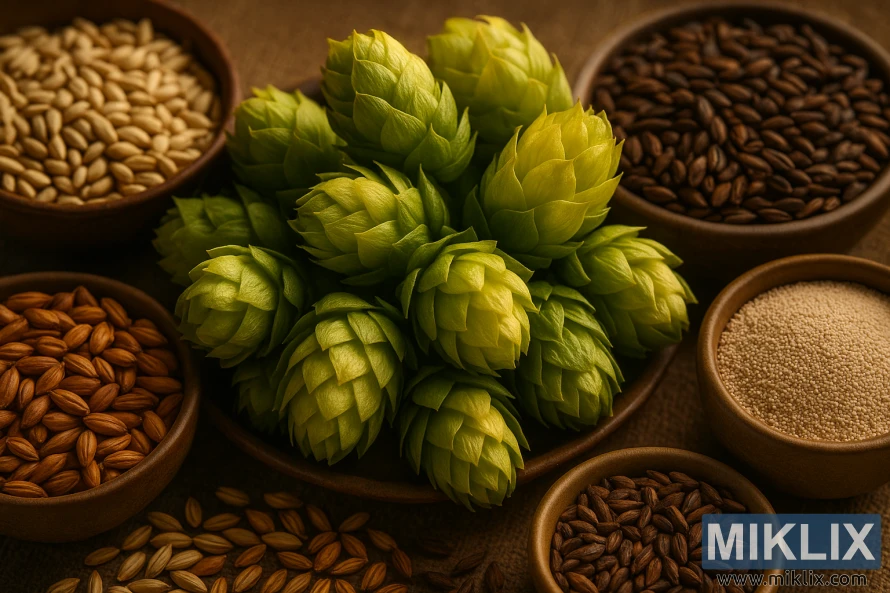
Riwaka Hops in Commercial and Homebrewing Practice
Craft brewers have showcased Riwaka's bright citrus and passionfruit notes in their beers. Hill Farmstead's single-hop pale ales, made with 100% Riwaka, emphasize floral top notes and a clean finish. These examples set the bar for aroma and hop intensity for breweries and beer enthusiasts alike.
For homebrewers, finding Riwaka can be a challenge. Specialty retailers and online marketplaces offer it, but availability and quality vary. Analytic sheets are crucial for understanding alpha acids and oil content. Amazon and independent hop shops list Riwaka when it's in season, with prices and formats differing by vendor.
Effective storage is key for homebrewers. Keep hops frozen and sealed to preserve volatile oils. Opt for pellets or whole cones over lupulin powder, as it's rare for Riwaka. Small test batches help gauge how Riwaka performs in your brewing setup.
Adjust your recipes based on the crop year. Suppliers provide ranges for alpha and beta acids, and essential oils. Use these to fine-tune bittering and late-hop additions. Single-hop trials allow for comparing different lots without committing to a large batch.
- Test small single-hop pale ales to map aroma over time.
- Store extra hops cold and use within months for peak freshness.
- Record lot numbers and supplier analytics to refine recipes later.
Many brewers suggest using Riwaka conservatively in late additions and dry hopping to preserve its delicate tropical notes. Taste samples at kegging and after conditioning to track the flavor profile's evolution. These practices ensure consistent results with Riwaka hops, whether you're brewing commercially or at home.
Substitutes and Complementary Hop Varieties
When Riwaka is hard to find, brewers seek out substitutes that capture its bright, tropical-lime essence. Motueka is a standout, with a citrus-lime profile that mirrors Riwaka. Citra, on the other hand, brings a strong tropical fruit and citrus punch, but with a different essential oil mix and higher intensity.
Saaz is a good choice for a milder, spice-driven lift. It shares a noble lineage and adds subtle citrus and herbal notes without overpowering the beer. Calypso offers tropical and citrus elements similar to Riwaka, but with a varying aroma strength.
Centennial serves as a reliable backbone hop. It contributes steady grapefruit and floral citrus, supporting fresher fruit-forward varieties. Blending Centennial with hops like Riwaka or Citra stabilizes the aroma while maintaining a lively citrus edge.
- Motueka — lime and bright citrus, close match for Riwaka’s fruitiness.
- Citra — powerful tropical and citrus flavors; use at lower rates to avoid dominance.
- Calypso — tropical/citrus character with a different intensity profile.
- Saaz — noble spice and gentle citrus; good for subtler interpretations.
- Centennial — citrus backbone that pairs well with fruit-forward hops.
For complementary hops, try blending Citra or Motueka with Riwaka to enhance tropical or lime notes. Centennial is effective as a supporting hop, adding structure. Adjust the rates and timing of additions to balance alpha acids and oils when swapping hops.
Keep in mind the impact of bitterness and aroma changes when substituting hops. Small test batches are crucial for fine-tuning quantities. This ensures the final beer retains the desired Riwaka-like lift without unexpected bitterness or aroma loss.
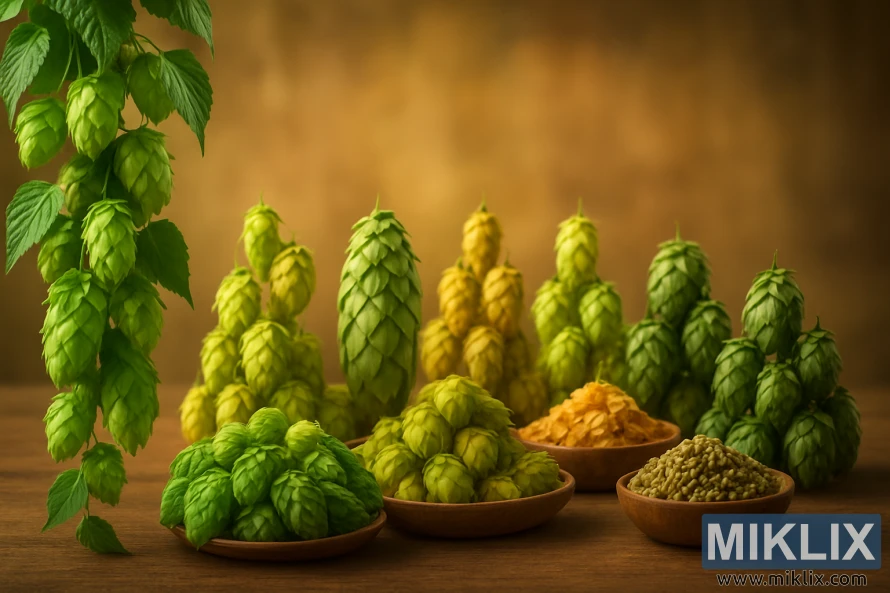
Availability, Purchasing, and Forms of Riwaka
Riwaka hops are available from several specialty hop suppliers in the United States and globally. Brewers looking to purchase Riwaka hops should verify stock levels with reputable vendors and online platforms. Availability can fluctuate based on harvest year and inventory levels.
Riwaka cones are available when whole-leaf lots or fresh New Zealand harvests are in stock. The New Zealand season for fresh hops runs from late February to early April. Thus, it's crucial to plan ahead for wet or fresh cones needed for single-batch experiments.
Riwaka pellets are the most common form, making storage and dosing easier. They are ideal for consistent bittering and late additions. On the other hand, whole cones are better suited for dry hopping and small-batch sensory work.
It's important to note that cryo, lupulin powder, and lupomax formats are not commonly found from major processors like Yakima Chief Hops, BarthHaas, or Hopsteiner. If you require these concentrated forms, confirm availability before making a purchase.
- Compare harvest years and lot analytics for alpha and beta ranges before formulating recipes.
- Check price per kilogram and minimum order quantities across suppliers to match batch sizes.
- Request lab sheets for the specific lot to verify oil content and expected contributions.
Proper storage is key to preserving aroma. Store Riwaka pellets and cones in vacuum-sealed packaging at low temperatures. Riwaka typically has total oils ranging from 0.8 to 1.5 mL per 100 g. Cold, airtight storage is essential to maintain the bright, zesty character.
When Riwaka is scarce, consider splitting orders or subscribing to supplier alerts. Small breweries and homebrewers can access cones or pellets by working with local distributors or joining cooperative buys. This strategy can help secure limited lots.
Sensory Evaluation and Tasting Notes for Riwaka Beers
Begin by focusing on the aroma of Riwaka beer. Gently swirl the glass and take short, focused sniffs. This will help you detect the resinous and fruity notes driven by myrcene. Look for bright tropical passion fruit, grapefruit, and citrus top notes before assessing the flavor.
Then, examine the depth provided by humulene and caryophyllene. These oils contribute woody, spicy, and mild pepper undertones, balancing the fruit. Note the resinous hop character that underlies the citrus lift.
- Fresh: intense passion fruit, grapefruit, sharp citrus.
- One month: softened top notes, woody spice emerging.
- Two months and older: aromatics may shift; some batches show altered scents during lagering.
Next, evaluate the mouthfeel and aftertaste. Riwaka offers a bright citrus lift and a lingering tropical bitterness, noticeable in late additions or dry hop. Bitterness is moderate, thanks to alpha acids near 4.5–6.5% and cohumulone between 29–38%.
Keep detailed Riwaka sensory records. Log analytics like AA% and oil composition alongside tasting notes. Track changes in fresh and aged samples to refine your preferences.
Use a simple score sheet for aroma, flavor, bitterness, balance, and finish. Repeat tastings to detect changes. Consistent records will help you refine dosing, timing, and pairing choices for brews featuring Riwaka hops.
Experimental Uses and Recipe Ideas with Riwaka
Single-hop Riwaka Pale Ale offers a straightforward way to explore its essence. Start with a clean two-row base malt. Add hops late in the whirlpool and dry hop for 3–5 days. This approach highlights the passion fruit and grapefruit notes, perfect for showcasing Riwaka's unique aromatics.
For a refined lager, consider brewing a Riwaka Pilsner. Use minimal late-hop additions and a subtle dry hop to enhance citrus flavors. Lagering and aging are crucial to test the beer's stability. It's essential to document lot numbers and sensory outcomes to ensure future batches meet the original vision.
To craft a Hazy IPA, combine Riwaka with Citra or Motueka in late additions. Opt for a soft water profile and a fruity yeast to add tropical fruit layers. Running split-batch trials can help compare the effects of pellets versus whole cones on haze and aroma.
- Whirlpool-only additions increase volatile oil retention. Avoid long boils for aroma hops.
- Cold-soak dry hop can extract delicate esters without harsh grassy notes.
- Run small-scale split batches to test dry-hop rates and forms.
Timing is key for fresh-hop Riwaka brews, aligning with the New Zealand harvest. Wet-hop beers differ from those using pellets, so treat these as experimental works. Log all sensory details to refine future batches.
Design trials for Riwaka experimental beers, focusing on hop chemistry, grist composition, yeast strain, and fermentation profile. Use consistent tasting protocols and score sheets. This will help create reproducible Riwaka recipes for both commercial and homebrew endeavors.
Technical Considerations for Brewers Using Riwaka
When starting with Riwaka technical brewing, it's crucial to plan for oil retention. This hop contains about 1.2 mL/100g total oil. Volatile aromatics can degrade during long boils. To preserve aroma, brewers should limit early additions and use late kettle hops. They should also employ whirlpool rests at cooler temperatures and cold dry-hop techniques.
Monitoring Riwaka stability in every batch is essential. Its high oil content and delicate esters are susceptible to degradation from heat, oxygen, and time. To protect the aroma, control oxygen pickup during transfers, reduce headspace in tanks, and cool rapidly after the whirlpool. These steps help preserve scent and flavor during conditioning and packaging.
Adjusting Riwaka hop dosage is key, based on alpha acid and brewing intent. Alpha values range from 4.5% to 6.5%. Use these analytics for bittering calculations. For aroma and dry-hop work, homebrewers typically use 0.5–2 oz per gallon. Commercial brewers should scale these amounts using the same ratio, validating with pilot batches.
- Boil time: keep early additions minimal for aroma beers to avoid stripping hop oils and increasing isomerization.
- Whirlpool: use cooler whirlpool temps and moderate dwell time to extract oils without driving off volatiles.
- Dry-hop timing: perform cold dry-hopping near fermentation temperatures to preserve esters and hop oils.
- Packaging: minimize oxygen transfer and maintain cold-chain distribution to extend perceived freshness.
Utilize lot-specific analytics from suppliers to refine recipes. Reference alpha, beta, and oil content on every purchase. Small changes in oil percentage or alpha acid can significantly alter bitterness and aroma intensity. Update the hop dosage and schedule with each new lot.
Conduct simple analytical checks during scale-up. Sensory trials after dry-hop and accelerated shelf tests can reveal losses tied to Riwaka stability. If aroma fades faster than expected, tighten oxygen control, shorten transit times, and adjust final dry-hop weights or contact times.
Process control and clear documentation are vital for Riwaka in a production setting. Record boil times, whirlpool temperatures, dry-hop temperatures, and tank fill oxygen. These records help recreate successful batches and diagnose aroma loss, ensuring consistent results across seasons and lots.
Riwaka hops
Riwaka (RWA), also known as D-Saaz, was introduced from New Zealand in 1996. NZ Hops Ltd oversees the variety, promoting it for late-addition aroma hops and dry hopping. This guide provides insights into its origins, harvest timing, and brewing applications for recipe planning.
The aroma profile is tropical, featuring passion fruit, grapefruit, and citrus. Some samples reveal unique notes, like a light diesel edge in lagers. This makes Riwaka ideal for adding bright, exotic top notes without excessive bitterness.
Chemical ranges set expectations. Alpha acids are near 4.5–6.5% with an average of 5.5%. Beta acids range from 4–5%. Total oils are about 0.8–1.5 mL/100g, averaging 1.2 mL/100g. Myrcene dominates at roughly 68.5%. These facts highlight Riwaka's aroma-forward and oil-rich nature.
Availability is straightforward. Riwaka is available as pellets or whole cones from various suppliers. Major processors rarely offer lupulin powder or cryoconcentrate. Plan purchases for the New Zealand harvest window, late February through early April, for fresh-hop opportunities.
Practical brewing tips: use Riwaka for late kettle additions, whirlpooling, and dry hopping to protect volatile oils. It significantly enhances pale ales, IPAs, and Pilsners when used carefully. Gentle storage and handling preserve its delicate tropical and citrus aromatics.
- Name/Code: Riwaka (RWA), SaazD / 85.6-23 (D-Saaz).
- Origin/release: New Zealand, released 1996; managed by NZ Hops Ltd.
- Typical use: aroma hop for late additions and dry hopping.
- Chemical ranges: AA 4.5–6.5% (avg 5.5%); Beta 4–5% (avg 4.5%); oils 0.8–1.5 mL/100g (avg 1.2); myrcene ~68.5%.
- Forms: pellets and cones; no wide lupulin powder or cryoconcentrate offerings.
- Harvest: late February–early April in New Zealand.
Utilize this Riwaka quick guide and RWA hop facts for recipe design or hop sourcing. Treat Riwaka as a high-oil, aroma-forward option. It requires gentle process control and timing to showcase its tropical-citrus character.
Conclusion
Riwaka conclusion: Riwaka, a New Zealand aroma hop, is celebrated for its intense tropical passion fruit, grapefruit, and bright citrus notes. These aromas stem from its high oil content and myrcene-dominant profile. Since its release in 1996, it has become a favorite for late additions and dry hopping, aiming for fresh, vibrant fruit flavors.
When using Riwaka hops, it's best to add them late in the boil, whirlpool, or as a dry hop to preserve volatile oils. Expect variations from year to year; always check supplier analytics for alpha, beta, and oil data before crafting your recipe. Remember, lupulin powders are not available, so you'll need to use pellets or whole cones. Store them cold to maintain their aroma.
Riwaka brewing tips: If you need to substitute, consider hops like Citra, Motueka, Calypso, Centennial, or Saaz. These can offer tropical fruit, citrus, or subtle herbal notes. Running small test batches and documenting sensory changes over time is crucial. This is even more important for lagers, where unusual aromatics like diesel have been noted in some lots.
U.S. brewers should experiment with Riwaka in recipes focused on aroma. Source hops from reputable suppliers and monitor lot-specific analytics for consistent results. Small-scale trials, careful storage, and late additions will help you maximize this distinctive hop's potential.
Further Reading
If you enjoyed this post, you may also like these suggestions:
